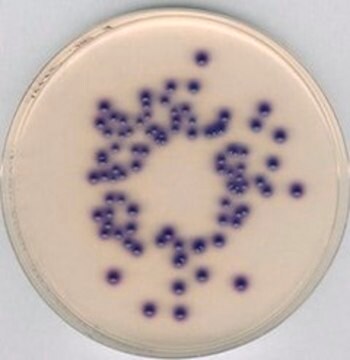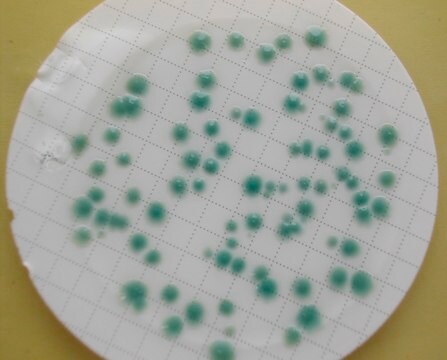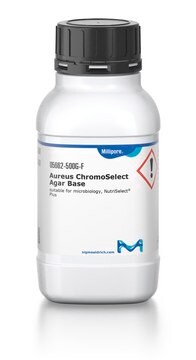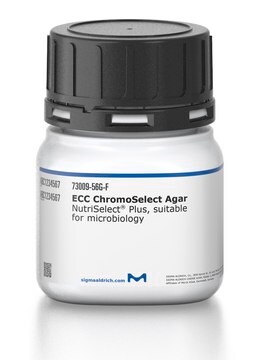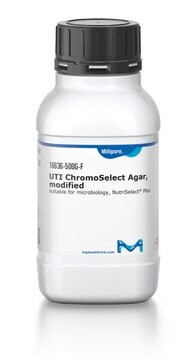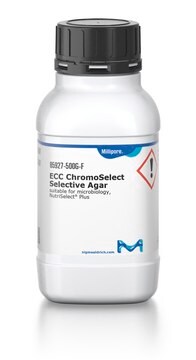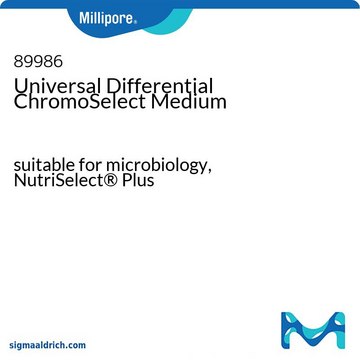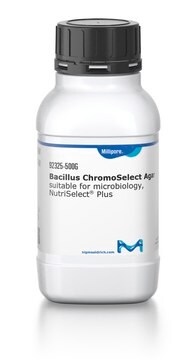00563
MM ChromoSelect Agar
NutriSelect® Plus, suitable for microbiology
Synonym(e):
ChromoSelect Miller and Mallinson Agar, MM Agar ChromoSelect
About This Item
Empfohlene Produkte
Form
powder
Qualitätsniveau
Haltbarkeit
limited shelf life, expiry date on the label
Zusammensetzung
agar, 15.0 g/L
D-cellobiose, 3.0 g/L
chromogenic mixture, 6.6 g/L
lactose, 10.0 g/L
D-mannitol, 1.2 g/L
peptone (vegetable), 10.0 g/L
D-trehalose, 1.33 g/L
vegetable extract, 2.0 g/L
Hersteller/Markenname
NutriSelect® Plus
pH-Endwert
7.6±0.2 (25 °C)
Anwendung(en)
clinical testing
environmental
food and beverages
pathogen testing
microbiology
Lagertemp.
15-25°C
Eignung
nonselective and differential for Citrobacter spp.
nonselective and differential for Escherichia coli
nonselective and differential for Salmonella spp.
nonselective and differential for coliforms
nonselective and differential for enterobacteriaceae
Anwendung
Angaben zur Herstellung
Fußnote
The designations basic, plus, or prime are added to indicate the quality control level, from basic quality control to standard QC plus to prime for full regulatory compliance.
Rechtliche Hinweise
Lagerklassenschlüssel
11 - Combustible Solids
WGK
WGK 3
Persönliche Schutzausrüstung
Eyeshields, Gloves, type N95 (US)
Hier finden Sie alle aktuellen Versionen:
Analysenzertifikate (COA)
Die passende Version wird nicht angezeigt?
Wenn Sie eine bestimmte Version benötigen, können Sie anhand der Lot- oder Chargennummer nach einem spezifischen Zertifikat suchen.
Besitzen Sie dieses Produkt bereits?
In der Dokumentenbibliothek finden Sie die Dokumentation zu den Produkten, die Sie kürzlich erworben haben.
Kunden haben sich ebenfalls angesehen
Artikel
Selective media enable faster results and visual confirmation for the detection, identification, and enumeration of microorganisms
Salmonella contamination is the second leading cause of food-borne illness worldwide. Controlling outbreaks of Salmonella is an important task for food regulators, restaurants and the food industry in general. The Salmonella family includes over 2,300 serotypes of bacteria, but two types, Salmonella enteritidis and Salmonella typhimurium, are responsible for about half of all human infections. Most outbreaks of Salmonella are traced back to dairy, poultry and meat products, but Salmonella can grow on nearly any food. Chicken, eggs and their derivative products are particularly high risk.
Unser Team von Wissenschaftlern verfügt über Erfahrung in allen Forschungsbereichen einschließlich Life Science, Materialwissenschaften, chemischer Synthese, Chromatographie, Analytik und vielen mehr..
Setzen Sie sich mit dem technischen Dienst in Verbindung.